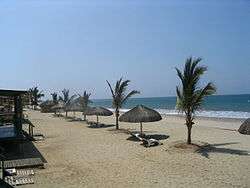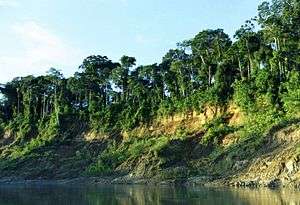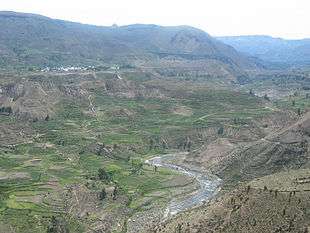List of protected areas of Peru
This is a list of protected areas in Peru.
Natural heritage

The Constitution of Peru of 1993 recognized the natural resources and ecosystem variety of its country as a heritage.[1] In 1900, the National System of Natural Areas that are protected by the Government (SINANPE) was created.[2] This entity depends on the National Service of Protected Areas by the State (SERNANP), Ministry of Environment.
Peru has 75 natural protected areas (15.21% of the country surface area[3]) that are preserved by the National Government: 12 national parks, 9 national sanctuaries, 4 historical sanctuaries, 15 national reserves, 3 wildlife refuges, 2 landscape reserves, 8 communal reserves, 6 protected forests, 2 hunting enclosed lands and 14 reserved zones. A map was also created containing the natural protected areas.[4]
Peru is considered to be among 17 of the most megadiverse countries in the world.[5] With over 1,700 species of birds, it has the world's second most diverse avian community, after Colombia.[6]
National Parks are places where the wild flora and fauna are protected and preserved. Natural resources exploitation and human settlements are forbidden.
National System of Natural State Protected Areas
National parks
- Cutervo, created in 1961 and located in Cajamarca, is the oldest Peruvian National Park. It contains many caves, including the San Andres Cave is a home of the endangered guacharo (oilbird) and golden quetzal.
- Tingo Maria is located in Huanuco Region. Its principal attraction is the Cueva de las Lechuzas (Owl Cave), another guacharo habitat.
- Manu, located in the Regions of Madre de Dios and Cuzco. In 1977, UNESCO recognised it as a Reserve of Biosphere; and in 1987, it was pronounced a Natural Heritage of Humanity.
- Huascarán is located in Ancash. It was also pronounced a Natural Heritage of Humanity and recognized as Reserve of Biosphere. Peru's highest snow-covered mountain (6,768 m) is found here, also named Huascarán. This park is the habitat of the Puya raimondii, the cougar, the jaguar, the llama, the guanaco, the marsh deer, the Peruvian tapir, the Peruvian piedtail, a hummingbird species, and many kinds of ducks.
- Cerros de Amotape (Amotape Hills) is located in Piura and Tumbes. It has many dry-climate forests and endangered species such as the American crocodile.
- The Abiseo River Park, another Natural and Cultural Heritage of Humanity site, is located in San Martín.
- Yanachaga–Chemillén, a tropical forest preservation zone at 4,800 m, is located in Pasco Region. The Palcazu River, Huancabamba River, Pozuzo River and their affluents flows through the park. Some native communities still live in here. There are also archaeological fields from the Inca and Yanesha cultures.
- Bahuaja-Sonene is located in Madre de Dios. It contains Puno Region's tropical forests, the Heath Pampas and part of the Tambopata National Reserve.
- Cordillera Azul
- Otishi
- Alto Purús
- Ichigkat muja – Cordillera del Condor
- Güeppí Sekime
- Sierra del Divisor, created in 2015, is located in Loreto and Ucayali at the border with Brazil.
- Yaguas, created in 2018, is a tropical forest protection zone along the Yaguas river located in Loreto near the border with Colombia.
National reserves
- Pampa Galeras – Barbara D'Achille is located in Ayacucho. It is the habitat of the vicuña.
- Junin is located in Junín. One of its main purposes is to protect the ecosystem and biodiversity of Lake Junín.
- Paracas is located in Ica. Its main purpose is to preserve the sea ecosystem and protect the historical and cultural heritage of the area.
- Lachay is located in Lima. Its main purpose is to restore and protect the ecosystem of the Lomas de Lachay (Lachay Hills).
- Titicaca is located in Puno. Its main purpose is to preserve Lake Titicaca's ecosystems and landscape.
- Salinas and Aguada Blanca are located in Arequipa and Moquegua. Their main purpose is to preserve flora, fauna and landscape.
- Calipuy is located in La Libertad. Its main purpose is to protect guanaco populations.
- Pacaya-Samiria is located in Loreto. Its main purpose is to preserve the ecosystems of the Omagua Region and to promote the indigenous towns.
- Tambopata
- Allpahuayo-Mishana
- Tumbes
- Matsés National Reserve
- System of Islands, Islets and Guano Sites National Reserve
- Pucacuro
- San Fernando National Reserve
National sanctuaries
National sanctuaries are areas of national importance for the protection of the habitat of specific species of flora and fauna, and natural formations of scientific or scenic interest.[2]
- Huayllay
- Calipuy
- Mejía Lagoons
- Ampay
- Manglares de Tumbes ("Mangroves of Tumbes")
- Megantoni
- Pampa Hermosa
- Tabacones Namballe
- Cordillera de Colán
Historical sanctuaries

- Chacramarca
- Pampas de Ayacucho ("Pampas of Ayacucho")
- Machu Picchu
- Pómac Forest
Wildlife refuges
- Laquipampa
- Pantanos de Villa
- Udima Cloud Forests Wildlife Refuge
Landscape reserves
Communal reserves
Communal reserves are conservation areas for flora and fauna, allowing traditional use for the rural populations surrounding the areas. The use and marketing of the natural resources within the communal reserve is conducted by the same rural populations.[2]
| Reserve | Date | Area (ha) |
|---|---|---|
| Yanesha | 28 April 1988 | 34,744 |
| El Sira | 22 June 2001 | 616,413 |
| Amarakaeri | 9 May 2002 | 402,335 |
| Asháninka | 14 January 2003 | 184,468 |
| Machiguenga | 14 January 2003 | 218,905 |
| Purús | 20 November 2004 | 202,033 |
| Tuntanain | 10 August 2007 | 94,967 |
| Chayu Nain | 9 December 2009 | 23,597 |
Protected forests
- Aledaño Bocatoma del Canal Nuevo Imperial ("Adjacent to the Nuevo Imperial Canal Intake")
- Puquio Santa Rosa ("Santa Rosa (Water) Spring")
- Pui–Pui
- San Matías–San Carlos
- Pagaibamba
- Alto Mayo
Enclosed hunting lands
- El Angolo
- Sunchubamba
Reserved zones

- Chancaybaños
- Güeppí
- Santiago-Comaina
- Waywash mountain range
- Sierra del Divisor Reserved Zone
- Humedales de Puerto Viejo Reserved Zone
- Nieva River Reserved Zone
- Lomas de Ancón Reserved Zone
- Bosque de Zárate Reserved Zone
- Illescas Reserved Zone
- Yaguas Reserved Zone
- Ancón Reserved Zone
- Huacachina Reserved Zone
National forests
- Biabo Cordillera Azul
- Mariscal Cáceres
- Pastaza–Morona–Marañon
- Alexander von Humboldt
Areas of regional conservation
- Chuqik'iraw
- Tamshiyacu Tahuayo
- Titankayuq
- Waytapallana
See also
- Iperu, tourist information and assistance
- Tourism in Peru
References
- Article 66-69 of the Constitution of Peru Archived 2007-03-24 at the Wayback Machine, retrieved 17 July 2012.
- SINANPE list of protected areas Archived 2012-04-24 at the Wayback Machine, retrieved 17 July 2012.
- Consolidated table of SINANPE Archived 2013-09-23 at the Wayback Machine
- Map of the protected areas in Peru Archived 2012-06-16 at the Wayback Machine
- Conservation International, South America Banks on Regional Strategy to Safeguard Quarter of Earth's Biodiversity Archived 2003-10-04 at the Wayback Machine. Retrieved on June 29, 2007.
- Lambertini, A Naturalist's Guide to the Tropics, excerpt
External links
- (in Spanish) SERNANP Official Website
